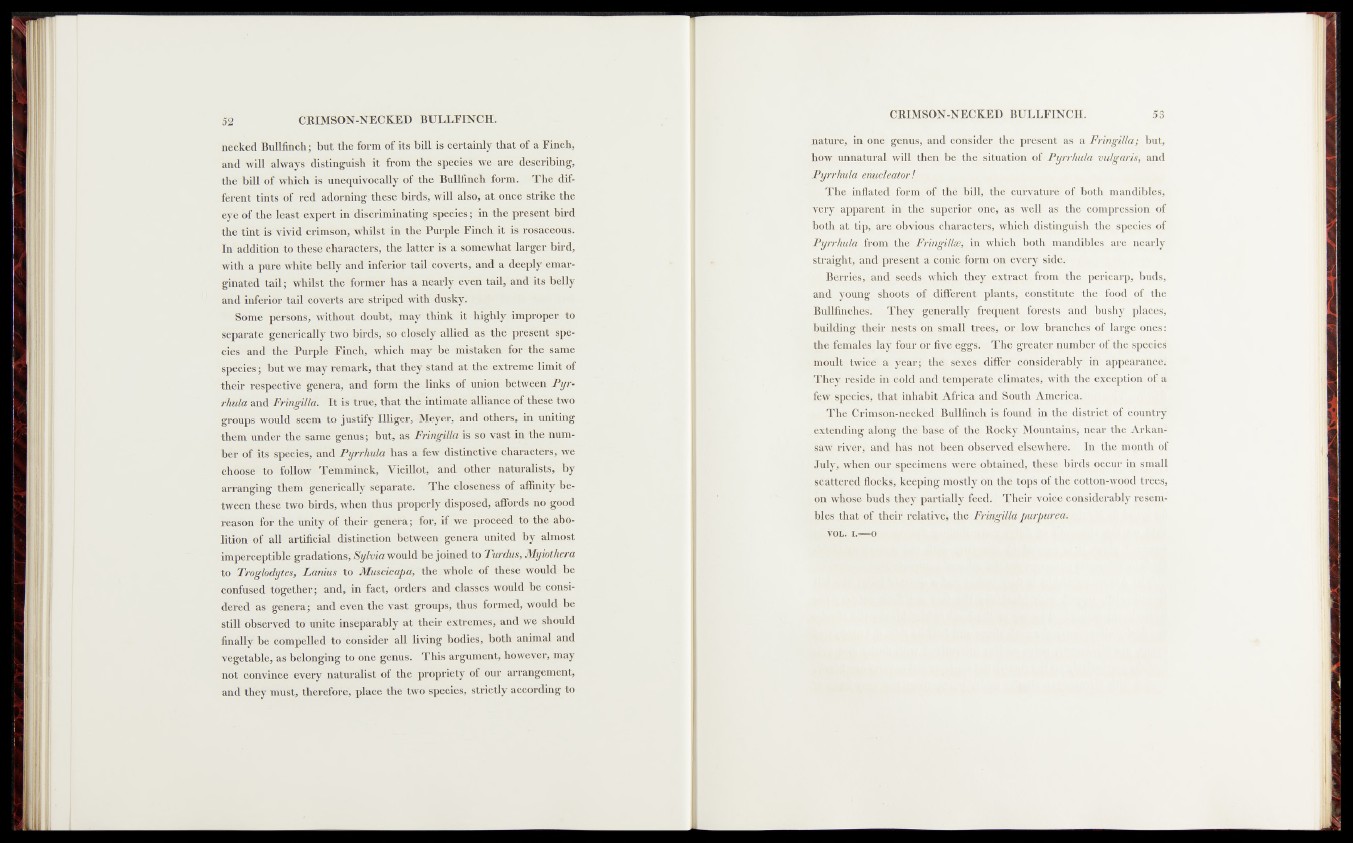
neeked Bullfinch; but the form of its hill is certainly that of a Finch,
and will always distinguish i t from the sptecies we are describing,
the bill of which is unequivocally of the Bullfinch form. -The different
tints of red adorning these birds, will also, at; once strike the
eyk Bf the least ekpert in discriminating species; in the present bird
the tint is vivid' hrifnSbn,’ whilst’in the Purple Finch itisi rosaceous.
In addition to "these characters, the latter is a somewhat larger bird,
with a pure white belly and inferior tail coverts, and a deeply emar-
ginated taft; whilst the former has a nearly.' even/? tail, and its belly
and inferior tail coverts are striped with dusky. • •
Some persons,1 without doubt, may think it highly improper to
separate generically two btfdspSd4i||t^ly allied as the present taper
ciesbknd the Purple Finch, which may h e ‘mistakentfo^he same
species; b u tw i may remark, that they stand at-theiextr&ihe-limit of
their respective genera, and ‘form the links of miaaqm between
rhula and Fringilld. It is S le , that the intimate/alliance ofith’ese two
groups would seem to justify Illiger, -Meyer, and others; in , uniting
them'under the same genus; but, as FringHiais so vast in tbemUm-
ber of its species* and Pyrrhula has a few distinctive,'Qh^racters,-we
choSsB» to follow Temrnnfck, Vieillot, and ‘other naturalists, b ||
arranging them generically separate. The closehess of affinity’fife-:
tween theii; two' birdk, when thus properly disposed, affords no:good
reason for the unity of their genera; for, if jfce proceed ,to the abolition''
of alb1 artificial distinction between genera united by. almost
imperceptible gradations, Sylvia would be joined to Turdus, Jjfyiothera
to Troglodyte's,Lanius to Muscicapa, the whole of these would be
confused together; and, in fact, orders and classes would be considered
as genera; and even, the vast groups, thus formed, would be
still observed to unite inseparably a t their extremes,’ and we should
finally be compelled to consider all living bodies, both animal and
vegetable, as belonging to one genus. This argument, however, may
not convince every naturalist of the propriety of our arrangement,
and they-must, therefore, place the two species, strictly according to
nature, h^ong» e^iaiskand. consider the present as a, Fringil^pjout,
how unnatural will thehf be the situation* bf Pyrrhula vulgaris, and
Ffyrifhula enuc£eqtorJ&&>$
The inflated fq|nj, óf thé bill, the curvature of both mandibles,
Kgry apparent in the superior .one. , as welk as the compression of
both at tip, are ^byiouA charaMèrsV.which distinguish the species of
Pyrrhula^ Ironi S n ^S um & lC )in nbiclkiftnth maadml&LLare nearly
straight* and- presént a*,èofiigfÓrm*1 oj^'e.yery side.
Berries, and .iséédsf which they. fronntlfe. pericarp, buds,
and young shoots ofii di'ffêi'ónS*"pl£fot>.’,«'onSljjlute llu’ food, pf the
Bullfinches. /They generally frequent forests and busbV places.
■MliMinef .theim heats bn small trees,ojifpw: branches of large ones.:
dffoffemales lay four" or fiye eggs. ThffigffaffÉ number of the specie^
1 twicetv& year; thé. sexèsi diffeif\cppsiderably in appearance*
They ||sid e in cold and temp'ei^ffilPlkmafoif with the êtómtfom ofié
fev# Specie SV tlfaty infralVlfa a n A'ShntM ttl
jrfijrRfi^.^riins©fimecked4Bullfihctt.,M#ffl^d'm the djstjfiets of 'country,
extending along théi basd bfo.|he' Rocky Mountains; me'Aikapf
saw rwêr^^dd, foas^riotf been' o b s e r v e d ,He m the month of
■Tufe^Wben our ^specimens wëjjd obtained^, these, birds Meur iff small
scattered flocks, keeping m ostly.^ thé tops ofidltiSimttqH-u ood trees,
pn whose buds they partialld ^ é f e TheifeVmrafeQiMdderablv resem2
bles that of their relative^., the Fringillcfapurpurea^
VOL. i.— o